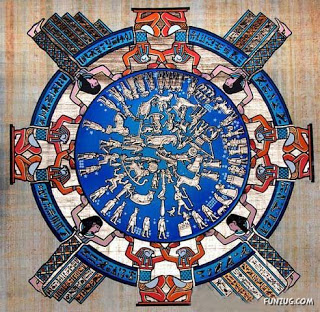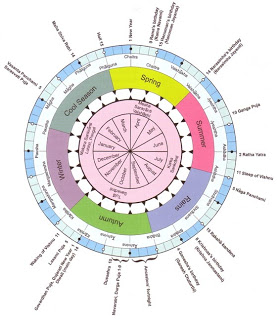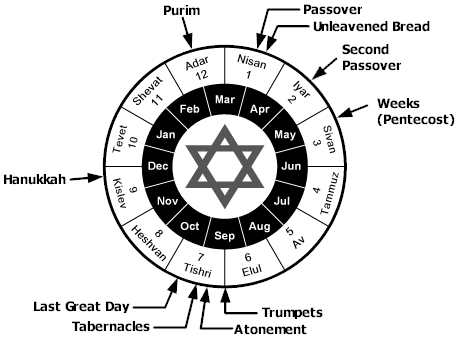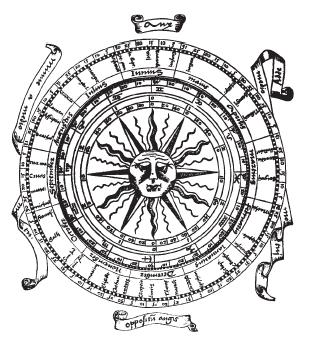

| Visitors Now: | |
| Total Visits: | |
| Total Stories: |

| Story Views | |
| Now: | |
| Last Hour: | |
| Last 24 Hours: | |
| Total: | |
Ancient Calendars, What Did They Mean? How Were They Used?
http://www.educatinghumanity.com
Ancient Calendars
Links to all the Calendars in this post
Egyptian Calendar
Bronze Age Sky Disk
Chinese Calendar
Bulgarian Calendar
Babylonian Calendar
Trundholm Sun Chariot
Phaistos Disk
Genetic Disk
Hindu Calendar
Jewish Calendar
Muslim Calendar
Hopi Calendar
Zuni Calendar
Cherokee Calendar
Aztec Calendar
Mayan Calendar
Gregorian Calendar
Since humans have been on planet earth we have been mesmerized by the passage of time. Little is know about prehistoric timekeeping but some records and artifacts have given us a glimpse into early man’s obsession with time. It suspected that even ice-age hunters over 20,000 years ago scratched lines in animal bone to mark the passage of time, possibly marking phases of the moon.
There are monolith structures all over the world that that were used as calendars, these magical wonders of architecture include Stonehenge, El Castillo to the Great Pyramids at Giza. Many of these structures have been left out of the history books but they are there for all to see, speculation abounds as to their reasons for being and their age but it is generally agreed that most were used to measure time.
At the Chichen Itza you will find that the 79 foot pyramid is built so precise and in such perfect alignment that during the spring and fall equinox a serpent shaped shadow slithers down the steps. The temple is listed as one of the New Seven Wonders of the World and is commonly called El Castillo.
Egyptian Calendar
The Egyptians are generally credited with devising the earliest known date: 4236 B.C., the founding of the Egyptian calendar. Dividing the day into 24 hours was an Egyptian idea. They took math very seriously working out complicated equations, geometry, fractions and even the decimal system. They invented the clock, metal pipes, of all things the toilet seats, looms, potters wheel, carpentry tools, scissors, keys, toothpaste, cement, devised reservoirs, irrigation systems, measured flood levels and last but not least they started the 365 day calendar.
The ancient civil Egyptian calendar dates back to the 5th Millennium, known as the Annus Vagus or “Wandering Year”. The Ancient Egyptian astrologers had long studied the stars which helped them in forecasting the seasons of flood and sowing which was vital to the prosperity of Egypt. The astronomers identified the planets in the solar system and also took great interest in the stars. The brightest star in the Egyptian sky was Sirius. Sirius disappeared for a 70 day period and reappeared on the eastern horizon on July 19th which also coincided with the Nile floods.
This was therefore the date of New Year’s Day for the Ancient Egyptians. The Ancient Egyptians had a great interest in the passing of time and how this effected vital events such as the annual flooding of the Nile.
Proyet was the time of the year when the Nile receded. Because the temperatures were much cooler than other times of the year this was the perfect time for the farmers to sow their crops. Proyet occurred normally from December to March.
 Shumo was summertime for the Egyptians. Lasting from March to July it was a dry time when the crops were harvested and was often one of the busiest times of the year. Because the crops were now in it was also the time when the tax collectors showed up for the Pharaoh’s share.
Shumo was summertime for the Egyptians. Lasting from March to July it was a dry time when the crops were harvested and was often one of the busiest times of the year. Because the crops were now in it was also the time when the tax collectors showed up for the Pharaoh’s share.
A group of German scientists has deciphered the meaning of one of the most spectacular archaeological discoveries in recent years: The mystery-shrouded sky disc of Nebra was used as an advanced astronomical clock. The purpose of the 3,600 year-old sky disc of Nebra, which caused a world-wide sensation when it was brought to the attention of the German public in 2002, is no longer a matter of speculation.
The Nebra disk may have been a ritual object or, more likely a calculating tool used with observations at Goseck or a similar site to determine planting and harvest times. The arrival of the stars in the night sky showed that it was time to start bringing in the harvest.
The disc was originally smeared with rotten eggs. These would have caused a chemical reaction on its bronze surface, which would have turned the disc’s background a deep violet color simulating a night sky out of which the gold-embossed stars would have shone.
The third arc on the disk is also highly interesting. The ancients did not understand how the sun could set in the west and end up in the east the next morning. Representations of a disk in a ship, from Bronze Age Egypt and Scandinavia, reveal an age-old belief that a ship carried the sun across the night sky. The Nebra disk is the first evidence of such a faith in central Europe.
Chinese Calendar
The calendar is based upon the Five Elements (metal, wood, water, fire,earth) concept which has been part of the Chinese concept of the essential components of the structure of the physical world. The other culturally important aspect of the ancient Chinese calendar is the zodiac animals that are assigned to each year.
Animal Personality Traits
Legend has it that in ancient times, Buddha asked all the animals to meet him on Chinese New Year. Twelve came, and Buddha named a year after each one. He announced that the people born in each animal’s year would have some of that animal’s personality.
- Rat: quick-witted, smart, charming, persuasive, quick temper and critical
- Ox: patient, kind, stubborn, conservative, tendency to have one’s way
- Tiger: authoritative, emotional, courageous, tendency to be hotheaded & stubborn
- Rabbit: popular, compassionate, sincere, overly sentimental and conservative
- Dragon: energetic, warm-hearted, charismatic, perfectionist, makes demands
- Snake: charming, wise, introverted, generous, needs humor & tight with money
- Horse: energetic, independent, impatient, enjoys traveling, egotistical
- Goat: Charming, elegant, artistic, quick to complain. Can be pessimistic at times
- Monkey: fun, energetic, active, opportunistic, can be distrustful
- Rooster: independent, practical, hard-working, shrewd, boastful, flashy dresser
- Dog: patient, diligent, generous, faithful, kind, Tendency to worry & find fault
- Pig: loving, tolerant, honest, and appreciative of luxury, naive, materialistic
If you want to look up your Zodiac Sign here is a link.
The Chinese calendar is still used today to choose the most auspicious date for a wedding or the opening of a building. Because each month follows one cycle of the moon, it is also used to determine the phases of the moon.
Bulgarian Calendar
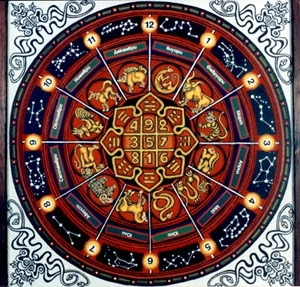 |
 |
The Ancient Bulgarian Calendar – 5505 years BC It is known that the ancient Bulgarians knew the basic laws of motion of the planets and the Earth around the Sun perfectly, and because of that they possess the most impeccable calendar ever created. The ancient Bulgarian calendar is based on observations of Jupiter and the Sun and is more precise than the modern Western (Gregorian) calendar we use today. The Bulgarians are the people with the most ancient system of measuring time – a fact, which indicates their early civilizing force. One of the primary uses of the early Bulgarian Calendar was to recognize the reign of each emperor.
For its 1400 years of statehood history and interesting geopolitical location, forming a strategic bridge between Asia and Europe, the ancient kingdom saw a long succession of invaders, conquerors, traders and settlers, who mingled with the ancient civilization and left their marks and artifacts for the future generation and the world to finally discover.
The Huns, in their travels, may have brought the Chinese method of timekeeping to Bulgaria. What is little known to most people is the striking resemblance of the Bulgarian calendar to the Chinese zodiac. If you look at the ancient calendar above you see that it is comprised of twelve signs, one for each month and each corresponding to an animal similar to the Chinese calendar.
The Babylonian Calendar
 |
 |
Theoretically, dates in ancient Babylonian texts can be converted to our calendar;
Babylonia (Babylonian Bâbili,”gate of God”; Old Persian Babirush),Was the ancient country of Mesopotamia, known originally as Sumer and later as Sumer and Akkad, lying between the Tigris and Euphrates rivers, south of modern Baghdâd, Iraq.
The Babylonians excelled at astronomy. Many of the constellations that we see in the sky were first categorized by them. The kept careful records and recorded celestial events under the belief they could shape future events. Under Hammurabi the Lawgiver, in 1800 B.C., star catalogs and planetary records were compiled.
 |
| Ziggurat or sky observatory |
The Neo-Babylonian used Ziggurat’s as observatories and mapped the night time sky into constellations. They developed the 12 signs of the zodiac, recorded the motions of the planets and even predicted eclipses.
The Sumerian administration needed a time unit comprising the whole agricultural cycle; for example, from the delivery of new barley and the settling of pertinent accounts to the next crop. This financial year began about two months after barley cutting. For other purposes, a year began before or with the harvest. This fluctuating and discontinuous year was not precise enough for the meticulous accounting of Sumerian scribes, who by 2400 B.C.E. already used the schematic year of 30 x 12 = 360 days.
At about the same time, the idea of a royal year took precise shape, beginning probably at the time of barley harvest, when the king celebrated the new (agricultural) year by offering first fruits to gods in expectation of their blessings for the year. When, in the course of this year, some royal exploit (conquest, temple building, and so on) demonstrated that the fates had been fixed favorably by the celestial powers, the year was named accordingly.
Trundholm Sun Chariot
Sun chariot, one of the most famous Bronze Age artifacts from Denmark. The sun chariot depicts a horse-drawn, six-wheeled wagon in cast bronze with a gold-covered sun disk that displays a spiral motif The sculpture is dated by the Nationalmuseet to about 1400 BC, though other dates have been suggested. The belief is that the disk was designed by a person with some measure of astronomic knowledge and that the sculpture functioned as a calendar. There is some school of thought that the Sun Chariot indicates that the sun, stars and earth are in perpetual motion.
The Sun Chariot illustrates the idea that the sun was drawn on its eternal journey by a divine horse. The two sides of the disk are considered as representations of the sun, on a chariot pulled by a horse across the heavens from East to West during the day, showing its bright side, the gilded one. During the night, it returns from West to East , showing his “dark side” to the Earth. A sun image and the horse have been placed on wheels to symbolize the motion of the sun.
Sol (Sun) is called “the bride of the sky” , across which she journeys daily in a chariot drawn by the horses Arvak and Alsvid, the chariot itself fashioned by the gods from a spark that flew out of Muspellsheim (Norse mythology means realm of fire). The Bronze Age Trundholm sun-chariot indicates that the daily journey of Sun’s horse-drawn chariot was an important component in Northern Europe’s ancient sun-cult. Julius Caesar, in his simplified account of Germanic religion, reports that the Germans worshiped fire (or Vulcan), together with the sun and the moon, an indication (among many others) that solar religion must have been more significant in earlier periods. Sol will be swallowed at Ragnarok by the wolf Skoll/Fenrir , but her daughter will eventually take her place in the reordered world . In the language of men the sun is called Sol; in the language of the gods she is called Sunna, which is also her name in the Second Merseburg Charm.
Phaistos Disk
Although there has been some controversy over the authenticity of the Disk it is widely believed to be genuine and is on display in the Heraklion Museum of Crete, Greece. Numerous theories have been suggested and range from the Phaistos Disk being a prayer token to a calendar to a message from ancient aliens. A recent and quite plausible theory is that it was a coded message that was read and then disposed of by dropping it into the pits. If this is the case it would represent one of the earliest forms of sophisticated encryption.
Genetic Disk
 |
 |
These are very strange artifacts from Colombia. They do not fit any existing pre-Colombian culture, the artifacts are considered to be at least 6,000 years old. To date there is no explanation as to what kind of technology was used to make such instruments and tools from lydite.
On the disk there are carvings that describes the astonishing knowledge of our ancestors. The disk was examined by the Museum of Natural History in Vienna, Austria. Dr. Vera Hammer, expert for precious stones analyzed the object.
On the edge of the disk there are symbols of a snake. There is a hole in the middle of the disk which give some indication that it may have been fixed to a rod or a stick and then turned so both sides could be seen. One side shows biological detail suchas sperms, female egg cells and genitals, the fertilized egg, fetus and a growing embryo. The other side shows what could be interpreted as cell division and the depiction of frog creatures at different stages.
It could be that this is a calendar that shows different phases of human life and evolution. Very significant are the distant lying eyes and the broad nose which is characteristic of the embryonic structure of the head.
Many scientist cried fraud when the disks was first discovered but this is not at all unusual when something does not fit into what we have been taught or what is out of the ordinary. There are many ancient relics that reside in museums around that globe that defy conventional explanation that have been quietly put into various museums. It seems that historians and academics would occasionally relegate these ancient technologies to a shelf in the museum storage room rather then attempt to explain them.
Hindu Calendar
In the “Brahma-Vaivarta Purana”, Lord Krishna tells Ganga Devi that a Golden Age will come in the Kali Yuga – one of the four stages of development that the world goes through as part of the cycle of eras, as described in Hindu scriptures. Lord Krishna predicted that this Golden Age will start 5,000 years after the beginning of the Kali Yuga, and will last for 10,000 years.
Mayan Calendar Matches Hindu Calendar
It is interesting that this prediction of the emergence of a new world is prophesied to appear about the same time that the Mayans predicted it to come! The Mayan calendar began with the Fifth Great Cycle in 3114 BC and will end on 21 December 2012 AD. The Hindu Kali Yuga calendar began on 18 February 3102 B.C. There is only a difference of 12 years between the Hindu’s beginning of the Kali Yuga and the Mayans beginning of the Fifth Great Cycle.
Golden Age Could Begin in 2012
The ancient Hindus mainly used lunar calendars but also used solar calendars. If an average lunar year equals 354.36 days, then this would be about 5270 lunar years from the time when the Kali Yuga started until 21 Dec 2012. This is the same year that the Mayans predict rebirth of our planet. It is also about 5113 solar years of 365.24 days per year, and is day number 1,867,817 into the Kali Yuga. By either solar or lunar years, we are over 5,000 years into the Kali Yuga and it is time for Lord Krishna’s prophecy to happen according to the ancient Hindu scriptures. Lord Krishna’s Golden Age could easily begin in 2012!
Mayan Prophecy Matches Hindu Prophecy
It is amazing that both calendars began at about the same time over 5,000 years ago and both calendars predict a totally new world and/or golden age after about 5,000 years into their calendars! These two calendars seem to give us a strong indication that a new era, a new dimension is arriving in 2012. Historically, this is an amazing fact since these two ancient cultures did not have any contact.
What does a calendar do? The simplest answer to this question is that it measures time. It also gives a sense of ‘controlling’ time which is another way of saying one has control of one’s life. But more than this, calendars were often produced for the purpose of worship, which is one of the primary focuses of the Jewish Calendar.
The Number 7 is a special number in Scripture and symbolizes divine perfection or completion. It is woven into every aspect of the Hebrew calendar. The Sabbath is observed on the 7th day of the week and every seventh year God decreed a Sabbatical year, and every seventh sabbatical year was considered a Jubilee year. Seven weeks after the Passover came the feast of Pentecost. The feast of Tabernacles, which is the last feast and completes the cycle, lasts for seven days. The seventh month is known as Tishri, and it contains the most holy days within the Hebrew calendar. Today they are referred to as the “High Holy Days.”
The Lord indeed created time yet He dwelt in a dimension that is beyond time and space. Time and space is where the sovereign God would meet with His highest creation, man.
Muslim Calendar
The Islamic Calendar, is as old as Islam. It dates back to the oldest known civilization. God in the Quran tells us that , our religion, Islam, is the oldest and same religion known to mankind. All God’s prophets and messengers came with the same message of submission, to submit to the One and only God.
Reviewing the history of calendars show that, when God created the universe, He created the Lunar and Solar calendar. It might be interesting to know that God used the word “MONTH” 12 times and the word “DAY” 365 times throughout the Quran.
In ancient Arab culture, there were traditionally four months during which the tribes agreed to an amnesty on any ongoing fighting. During the months of Muharram, Rajab, Dhul-Qi’dah, and Dhul-Hijjah, any battles were to be automatically suspended in order to allow for trade and travel in the area. This tradition was upheld in Islam, and these four months are called the “forbidden months.” However, if only one side observes the automatic truce and the other side continues fighting, the party observing the truce is obliged to defend itself.
Hopi Calendar
The Hopi religious calendar begins anew each year in November with the Kelmuya season. Only those who have been initiated into “manhood”
may participate in the ceremonies, which celebrate the creation of the present world, the Fourth World. Kelmuya (November) Fourth World Creation, Month of the SparrowHawk, Native Americans followed the movements of the celestial markers – much as we do today. They called it Star Knowledge. Beyond the land where they lived, was the sky, and that beyond were dimensional portals or sky holes. Beyond that was an area that they called the Ocean of Pitch, were the beauty of the night sky and the galaxies spun out towards them. Beyond that were the boundaries of the universe. And that set along the rim at the boundaries of the universe were 4 different extraterrestrial groups.
The Hopis called the Pleiadians the Chuhukon, meaning those who cling together. They considered themselves direct descendants of the Pleiadians. The Navajos named the Pleiades the Sparkling Suns or the Delyahey, the home of the Black God. The Iroquois pray to them for happiness. The Cree claim they came to earth from the stars in spirit form first and then became flesh and blood.
Zuni Calendar
The Zuni year is divided into two seasons, inaugurated by the solstices, each of which is composed of six months–lunations, subdivided into three ten-day periods. The significations of the month names are interesting: the month of the winter solstice, which is the beginning of the year, is called Turning-Back, in reference to the Sun Father’s return from the south; it is followed by Limbs-of-the-Trees-Broken-by Snow, No-Snow-in-the-Road, Little-Wind, Big-Wind, and No-Name. For the remaining half of the year, these appellations, though now inappropriate, are used again, the months of the second half-year being, strictly speaking, nameless.
Both Zuni and Hopi have priests whose special duty is to observe the annual course of the sun, and hence to determine the dates for the great festivals of the winter and summer solstices. The Zuni sun priest uses as his gnomon a petrified stump which stands at the outskirts of the village, and at which he sprinkles meal and makes his morning prayers to the sun, until, on the day when that luminary rises at a certain point of Corn Mountain, the priesthood is informed of the approaching change. Every fourth morning, for twenty days, the sun priest offers prayer-plumes to the Sun Father, the Moon Mother, and to departed sun priests;
Cherokee Calendar
We are all made of stars. In Cherokee belief, the departed souls arise into the sky to become stars, and it is from the stars that souls come to earth to be born as children. The planets, stars, and constellations, the “Star People” showing their faces at the birth of a child, speak to his or her strengths and weaknesses and to destiny’s role for that individual.
The link between the People and the stars, between Earth and Heaven, is so strong that it’s even claimed that our ancestors came to earth “from the Pleiades.” At the end of the Seventh World, it’s said that we will return to our home in the sky.
Aztec [Sun] Calendar
|
|
The Aztec calendar was an alteration of the Mayan calendar. It consisted of a 365 day agricultural calendar as well as a 260-day sacred calendar. It is currently on display at the Museo Nacional de Antropologia in Mexico City, Mexico. What’s fascinating about this calendar is that every year has a “no time” period-days “outside the calendar” to freely celebrate life. There are a total of five “nameless days” at the end of every Mayan solar year. This is supposed to be a phase of transition and preparation for the next year. Most people mistakenly believe the Aztec and the Mayans were philosophically and geographically kindred spirits. That is not the case at all, to read about the differences between the Aztec and Maya click here.
Mayan Calendar
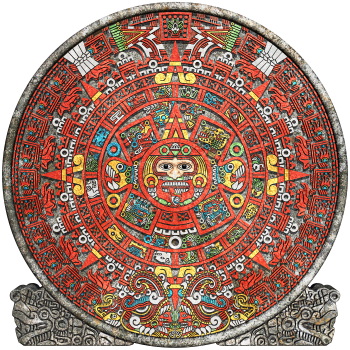 |
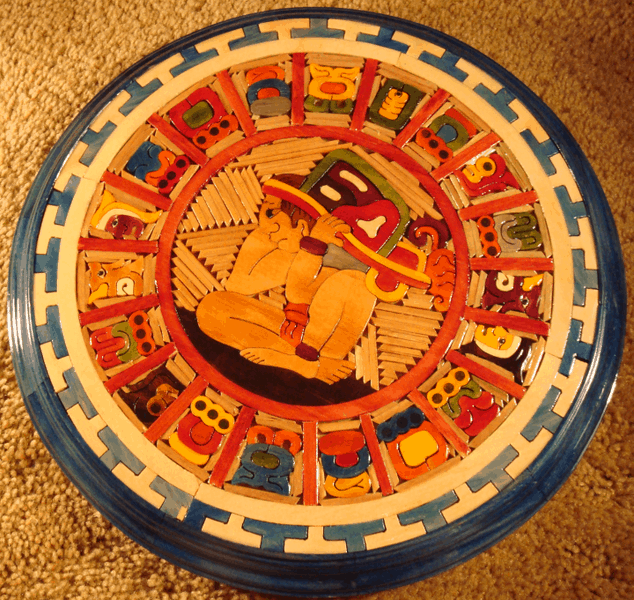 |
Ancient Maya Calendar Modern depiction of Ancient Calendar
Incredibly, the Maya understood that our world turned, but they also knew that it was only a part of a larger solar system that moved independently through our galaxy. This end-date of the Long Count Calendar December 21, 2012 marks the coming of a truly rare cosmic event that will occur when this procession of the equinoxes positions our solar system in the very center of our galaxy when Earth will cross the ecliptic path of the sun.
The world is talking about what will happen on this date, however, not everyone is looking forward to it with the same set of expectations. For some, 2012 hints at a coming apocalypse but more optimistic views believe that, as the Maya claimed, we would begin to experience some form of spiritual awakening, perhaps initiated by some cosmic event or compelling miracle. But, we have no way of knowing for sure what effects these cosmic events will have on Earth, as the last time an alignment like this took place was over 150,000 years ago!
The notion of 2012 being the end of the world is actually fairly new, it was first suggested by New Age religionist José Argüelles in his 1987 book The Mayan Factor: ‘Path Beyond Technology’. You can rest assured that when you wake up on Dec 22, 2012 there may have been a change in the cosmic universe but the earth as you know it will be intact!
Gregorian Calendar
The Gregorian Calendar is what the vast majority of the world uses today. The original goal of the Gregorian calendar was to change the date of Easter.In 1582, when Pope Gregory XIII introduced his Gregorian calendar, Europe adhered to the Julian calendar, first implemented by Julius Caesar in 46 B.C. Since the Roman emperor’s system miscalculated the length of the solar year by 11 minutes, the calendar had since fallen out of sync with the seasons. This concerned Gregory because it meant that Easter, traditionally observed on March 21, fell further away from the spring equinox with each passing year.
1. Leap years don’t really occur every four years in the Gregorian calendar.
2. The Gregorian calendar differs from the solar year by 26 seconds per year.
3. Some Protestants viewed the Gregorian calendar as a Catholic plot.
4. Britain’s adoption of the Gregorian calendar sparked riots and protest.
5. Before the Gregorian calendar’s adoption, the English new year began on March 25, or Lady Day.
The Gregorian calendar, also known as the Western calendar, or Christian calendar, is the internationally accepted civil calendar. It was introduced by Pope Gregory XIII , after whom the calendar was named, by a decree signed on 24 February 1582, a papal bull known by its opening words Inter gravissimas. The reformed calendar was adopted later that year by a handful of countries, with other countries adopting it over the following centuries. The motivation for the Gregorian reform was that the Julian calendar assumes that the time between vernal equinoxes is 365.25 days, when in fact it is presently almost exactly 11 minutes shorter. The error between these values accumulated at the rate of about three days every four centuries, resulting in the equinox occurring on March 11 (an accumulated error of about 10 days) and moving steadily earlier in the Julian calendar at the time of the Gregorian reform. Since the Spring equinox was tied to the celebration of Easter, the Roman Catholic Church considered that this steady movement in the date of the equinox was undesirable, hence the birth of the Gregorian Calendar.
http://donsmaps.com/skydisc.html
http://www.thekidswindow.co.uk/News/Ancient%20Egyptians
http://256.com/gray/docs/calendar.html#
http://www.helium.com/items/1512507-ancient-bulgarian-calendar-and-chinese-zodiac
http://projectavalon.net/forum4/showthread.php?40256-Ancient-Calendars-
http://www.webexhibits.org/calendars/calendar-ancient.html
http://www.funzug.com/index.php/artwork/amazing-art-of-ancient-calendars.html
http://donsmaps.com/skydisc.html
http://mexican-jaguars.tripod.com/nahuamayanumbersystem/id17.html
http://mexican-jaguars.tripod.com/nahuamayanumbersystem/id17.html
http://www.netplaces.com/understanding-islam/islamic-holidays/the-islamic-calendar.htm
http://coupmedia.org/archaeology-0103
http://egotvonline.com/2012/05/15/20-ancient-calendars-to-screw-up-the-apocalypse-timetable/
http://www.bible-history.com/jewishyear/jewishyear_overview.html
http://sjkt-keruh.blogspot.com/2011/04/it-is-5113-years-had-elapsed-in-hindu.html
National Museum, Copenhagen, Denmark
http://www,educatinghumanity.com
2012-12-15 21:41:51
Source:



